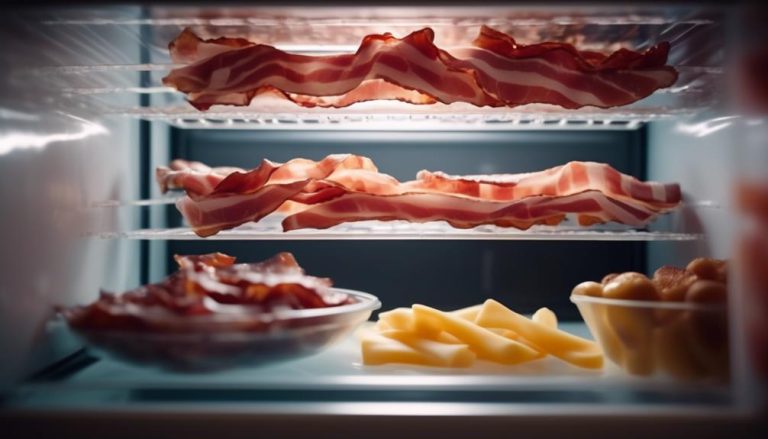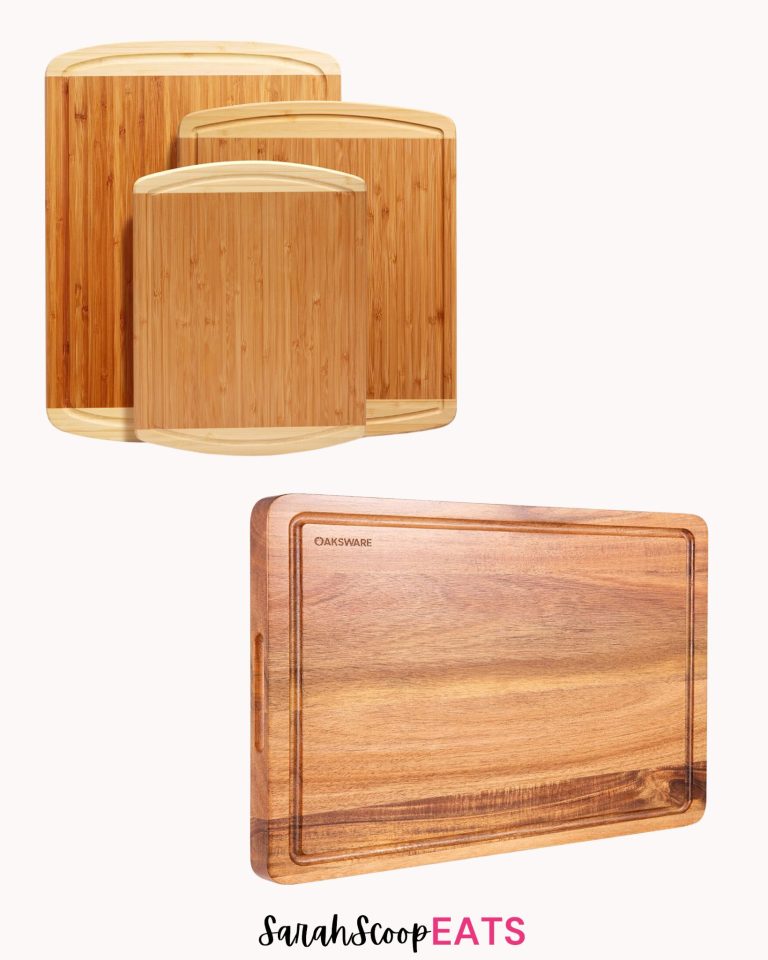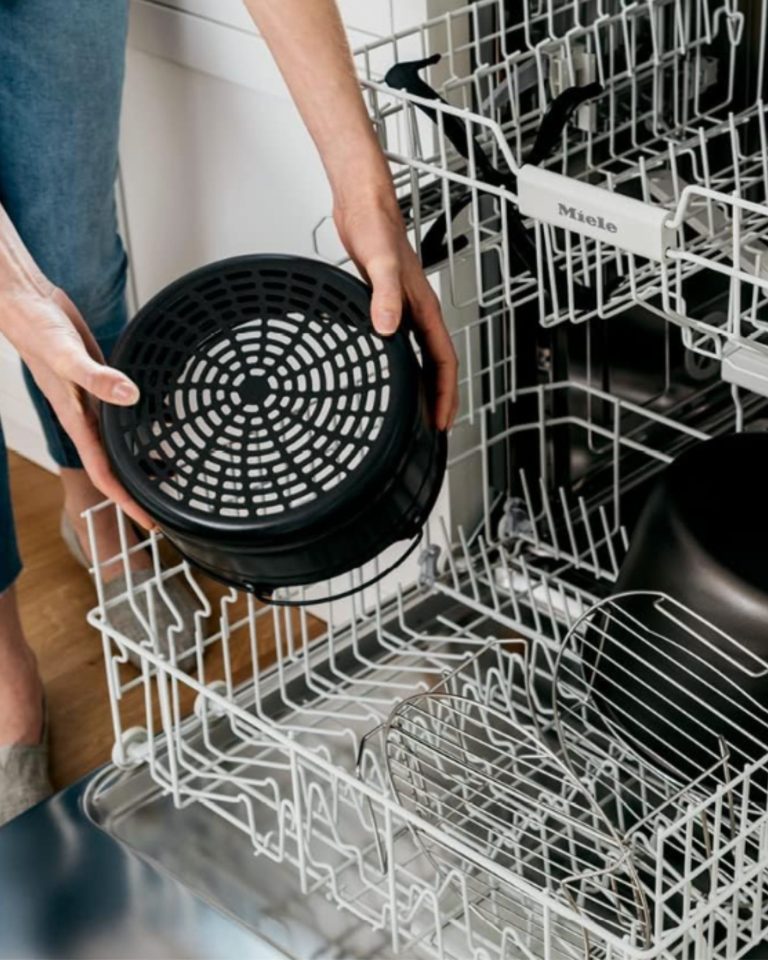When Can You Put Food In A New Fridge: How Long To Wait
Keeping your perishable items in the right place and at the proper temperature is crucial for maintaining their freshness. Here’s the scoop on when can you put food in a new fridge!
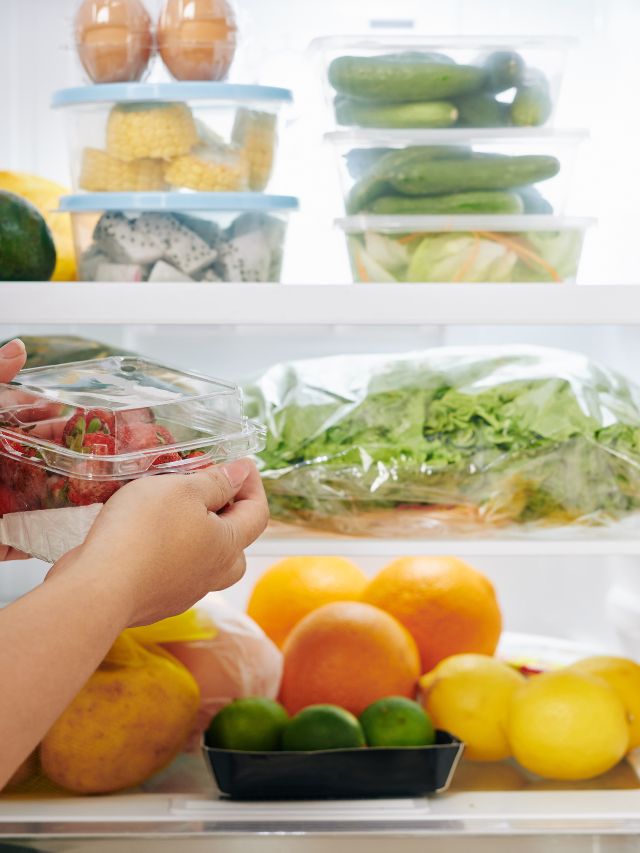
Purchasing a new fridge can be an exciting experience, but it’s essential to understand when it’s safe to store your food inside and what the wait time for your new appliance is going to be like.
You finally got rid of your old fridge, but now comes the next steps.
You need to make sure you don’t end up with warm food after not waiting for enough time, as the wrong refrigerator temperature and warm air can lead to bacterial growth for your favorite foods.
It’s important to keep your food cold and preventing any unwanted bacteria growth, leading to food waste or food poisoning as a worst-case scenario.
While there’s no one-size-fits-all answer when it comes to temperature control, some general guidelines suggest when it’s safe to put food in a new fridge for the first time.
No matter what type of refrigerator you have, you can keep your fresh food safe at a cool temperature after installing a new fridge.
New Fridge
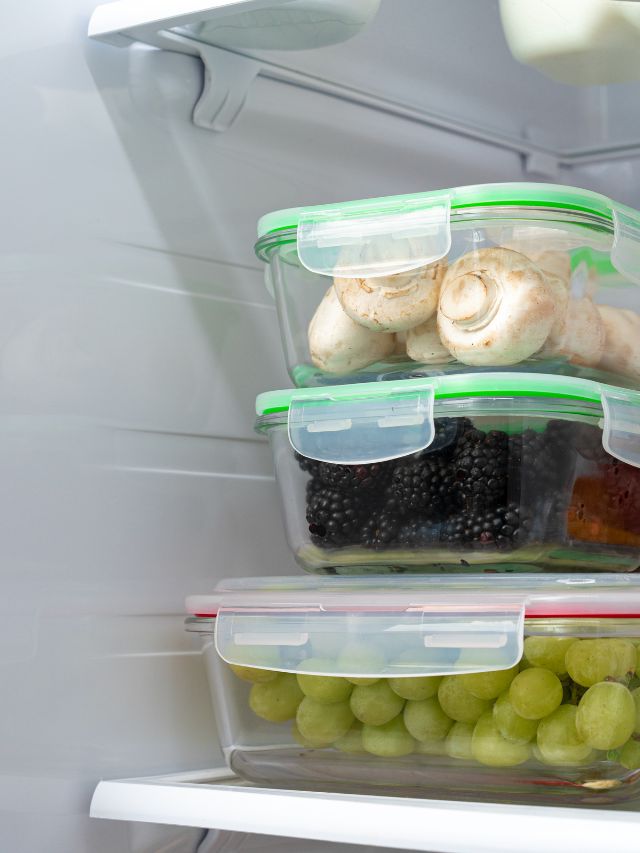
The key is understanding your refrigerator’s temperature and the required time it takes to complete the cooling process to prevent foodborne illness
As a general rule, it’s a good idea to wait at least 2 hours and up to 24 hours before placing food in a brand-new refrigerator.
This might seem like a long time, but you want to make sure that the internal components of your new fridge. Especially the freezer compartment, are at the right temperature
This timeframe allows the appliance to reach its optimum temperature for preserving your groceries safely. Making sure your food from the freezer section stays out of the danger zone.
Duration
The specific duration may vary depending on the make and model of your fridge. Such as mini fridges or a bigger fridge like regular full-size refrigerators.
Different models may require different temperatures, particularly for your fridge freezer, which needs to collect ice that preserves frozen foods.
For example, Samsung recommends waiting at least two hours for their refrigerators to cool before storing food.
On the other hand, Whirlpool suggests allowing 24 hours for their refrigerators to achieve full functionality.
It’s important to follow the manufacturer’s guidelines specific to your refrigerator model number to ensure optimal performance and food safety and to determine accurate internal temperature when you test the fridge after a set number of hours.
The best way to determine if your fridge has had the proper cooling time is by checking the fridge with a separate thermometer and comparing it to the average temperature of a refrigerator based on the model.
Storing food too early could potentially overwork your fridge’s compressor, or cooling lines, which is not an ideal way to start the appliance’s life.
This could deplete your fridge’s power supply and cause it to provide less energy for your food.
By waiting the recommended time, you can be confident that your new refrigerator is functioning effectively. Plus your food will be kept fresh and safe.
When to Put Food in a New Fridge
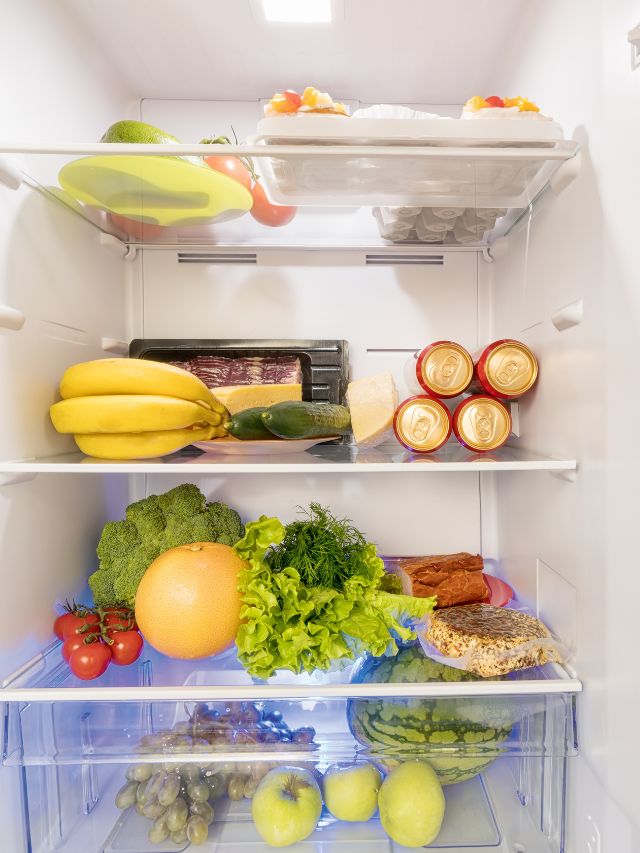
Waiting Time After Delivery
When you get a new refrigerator, it’s essential to wait before placing food inside.
As a general rule, plan to wait a minimum time of 2 hours and a maximum of 24 hours before storing food in your brand-new fridge.
This allows the refrigerator to reach its optimal temperature and also ensures that the control panel and air vents are functioning properly on their own.
According to the USDA, your fridge should reach at least 40°F (4°C) before putting food in it.
In the meantime, you can fill your fridge about 2/3rds full with water bottles to help it maintain the cold temperature. Especially since you lose cold air each time you open the door.
Placing water to be made into ice cubes or gel packs at the bottom of the fridge will also help determine if your fridge is still at a higher temperature.
As the ice won’t freeze if the fridge is still at an ambient temperature.
Transported on Its Side
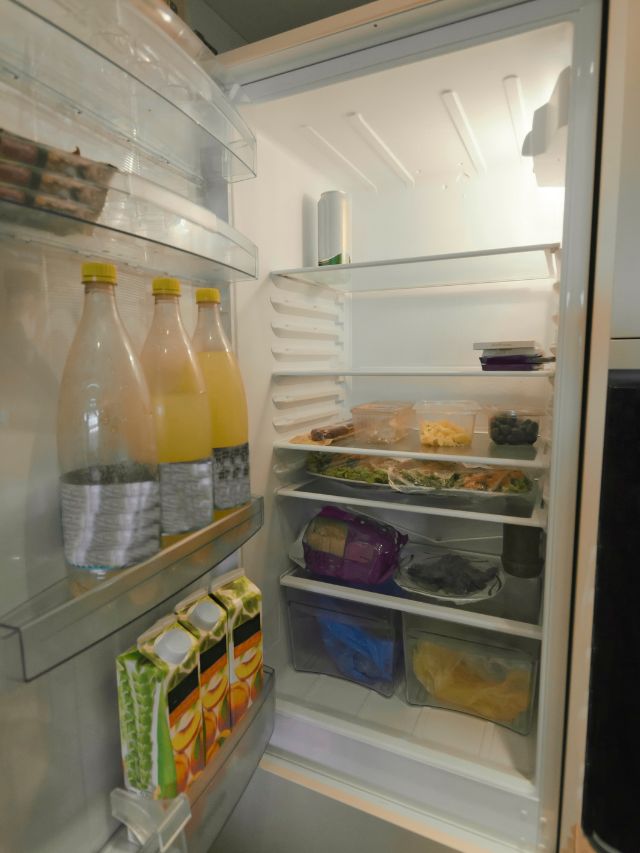
If your new refrigerator was transported on its side during delivery, it is recommended to let it stand upright for a specific amount of time.
This is to allow the compressor oil in the cooling system to settle and ensure proper functioning after being placed in a straight position.
Appliances with a single-door configuration need around 1 hour. Whereas fridges with double doors, a side-by-side refrigerator, or French-door fridge configurations may require up to 3 hours.
Determine what kind of refrigerator doors you have before installing them.
| Fridge Configuration | Stand Upright Time |
| Single Door | 1 Hour |
| Double Door | 3 Hours |
| Side-by-Side | 3 Hours |
| French Door | 3 Hours |
Stand Upright Time
Regardless of whether the fridge was transported on its side or not, it is essential to let the appliance sit in its upright position before turning it on.
For most refrigerators, this usually takes a minimum of 2 hours.
During this time, you should also avoid opening the door, as doing so may strain the appliance unnecessarily.
While you’re waiting, take a clean cloth and wipe down the outside of the fridge with soapy water first thing, including the fridge door.
This will pass the time but also ensure that your new fridge is clean for your food!
It’s essential to follow the waiting and stand-upright guidelines for your new refrigerator to ensure it reaches the proper temperature.
Which in turn will keep your food fresh and preserved while maintaining the overall functionality of the appliance.
Preparing the Fridge for Food Storage

Before you store food in a new fridge, it’s essential to prepare it properly.
This includes allowing time for settling lubricants and coolants, cleaning the interior, and positioning the fridge in the correct location.
This will ensure optimal performance and food safety.
Settling Lubricants and Coolants
When a new fridge is transported, lubricants and coolants inside the system may have shifted.
It’s important to give your fridge some time to settle the lubricants and coolants before you start using them.
Typically, it’s best to wait two to four hours after plugging in the fridge.
This will allow the fridge to reach its ideal operating temperature. Ensuring proper cold food and overall food safety in the long run.
Clean the Interior
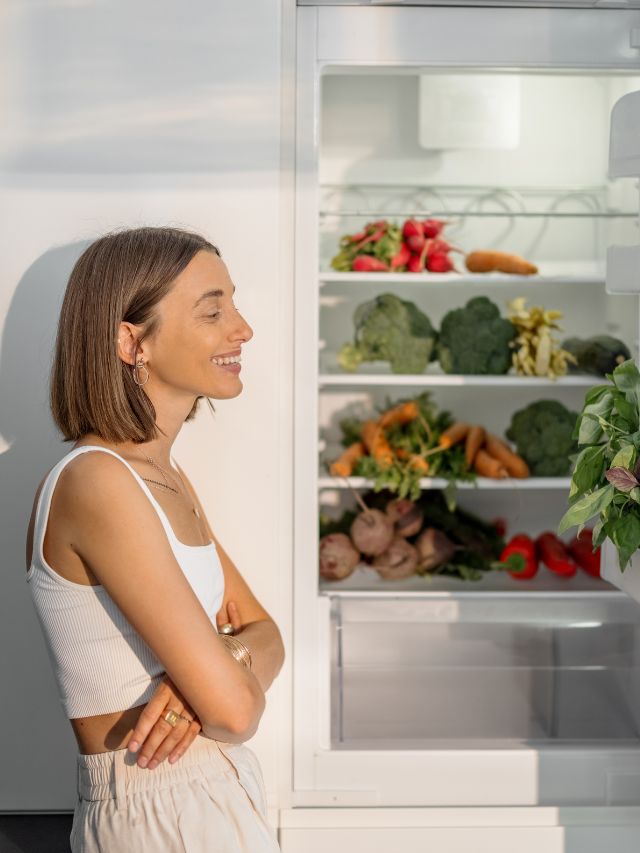
Before you start putting food inside your new fridge, it’s a good idea to clean the interior as you did with the exterior.
This helps remove any dust, debris, or manufacturing residues left behind during the production process.
Use a mild detergent mixed with warm water, and wipe the surfaces with a soft piece of cloth.
Make sure the ice maker is cleaned thoroughly as well to prevent bacterial growth once block ice starts to form in the freezer.
Clean the appliance thermometers as well.
Be sure to also dry the interior thoroughly before adding food items.
Location and Position
The location and position of your fridge can affect its performance and energy efficiency.
Here are a few tips for placing your new fridge:
- Choose a location with adequate ventilation to ensure proper heat dissipation. This will help prevent overheating and prolong the life of your fridge.
- Ensure your fridge is level and stable. Uneven positioning can cause abnormal noise, vibrations, and even affect the fridge’s cooling system.
- Avoid placing the fridge near heat sources or in direct sunlight. Excessive heat can reduce the efficiency of your fridge and requires it to work harder to maintain its temperature.
- Leaving some space between the fridge and the wall allows for better airflow and improved cooling.
By following these guidelines, you can ensure that your new fridge is ready and safe for food storage.
Temperature Settings and Cooling
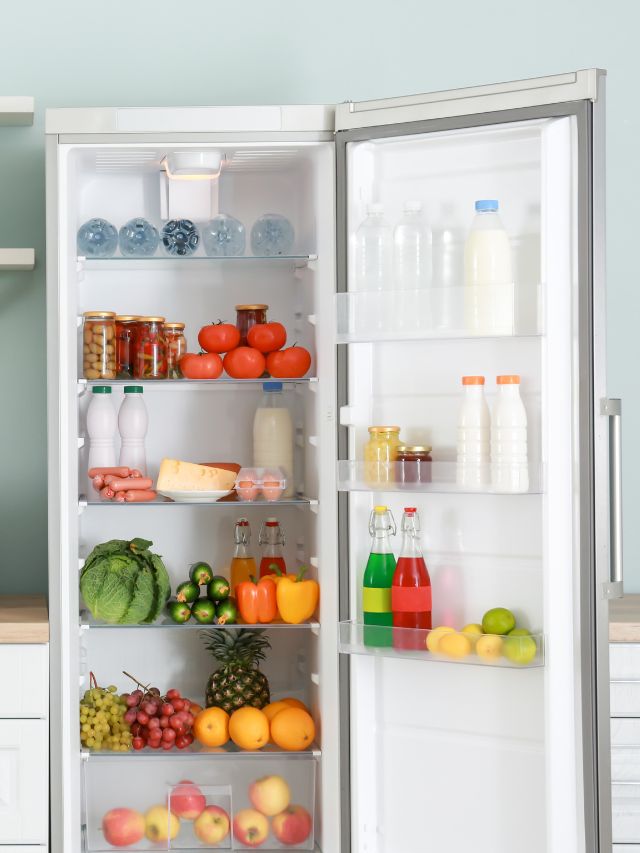
Thermostat Settings Guide
When setting up a new fridge, thermostat settings can make a significant difference in how well the appliance cools stored food items.
It’s essential to ensure the temperature inside your refrigerator reaches the FDA-recommended food-safe temperature of 40°F (4°C) within a reasonable time frame following installation.
- Aim for a thermostat setting that achieves and maintains the ideal temperature for safe food storage.
- Different makes and models of refrigerators may have varying temperature setting recommendations.
The optimal temperature will also let your food cool easily after you’ve placed your hot meals in plastic wrap for next time.
Achieving Optimum Temperature
It takes time for a new refrigerator to reach its optimum temperature.
In most cases, you should wait at least 2 to 24 hours before placing food inside.
That way, you allow the appliance to stabilize its internal temperature and ensure safe storage conditions for your food.
- Waiting for at least 2 hours is usually adequate for many refrigerators.
- Up to 24 hours may be necessary for certain models, especially larger or differently designed refrigerators.
- In the case of a Samsung refrigerator, it’s recommended to wait for 2 hours before storing food in it.
Balancing Hot and Cold Air Mix
Achieving a balanced hot and cold air mix is essential for refrigerator efficiency and food safety.
Your refrigerator has various sections: the main fridge compartment, the crisper, and the freezer.
To ensure proper air circulation and temperature stability:
- Increase max settings initially for at least two hours to initiate rapid cooling.
- After the initial cooling period, adjust the thermostat settings to stabilize the desired temperature in each compartment.
- Regularly check the temperature in different sections of the refrigerator.
- Avoid overloading the refrigerator, as doing so may cause temperature fluctuations and impede airflow.
Storing Food in the Refrigerator and Freezer

Organizing Food Items
When storing food in a new fridge, it’s essential to organize items properly to ensure their freshness and prevent cross-contamination.
Keep raw meats, seafood, and poultry in sealed containers or plastic bags, stored on the bottom shelves to avoid dripping onto other foods.
Place fruits and vegetables in designated compartments, like crisper drawers, to help maintain their freshness.
Place freshly-made soup in a separate area for it to cool and not contaminate other foods.
Dairy products such as milk, hard cheese, and yogurt should be kept at the back of the fridge and in close-together containers, for consistent cold temperatures.
While ice cream and dry ice should go in the freezer.
Packaging and Space
Proper packaging plays a crucial role in preserving food quality and preventing spoilage.
Store food items in airtight containers or plastic bags and avoid overstuffing the refrigerator, as proper air circulation is essential for maintaining consistent temperatures throughout.
It’s recommended to leave a small space between items to allow cool air to flow freely.
Storing Leftovers
To keep leftovers safe, it’s essential to follow the two-hour rule and refrigerate them within two hours of cooking.
Use shallow containers to ensure quick cooling and label them with the date to ensure timely consumption.
Leftovers should be consumed within 3–4 days or frozen for later use if necessary.
If you have large batches of hot foods, make sure you wait for a sufficient amount of time before storing them in the fridge.
Frozen Food Storage
Storing frozen food is crucial for maintaining the quality and safety of your items.
The freezer should be set at 0°F (-18°C) to stop bacteria from growing.
Organize frozen items by grouping them into categories, such as meats, vegetables, and prepared meals.
Use food storage containers or heavy-duty plastic bags and remember to label items with the date of freezing.
Frozen foods can be stored indefinitely at 0°F or below, but their quality may decrease over time, so it’s best to use them within the recommended storage times.
Food Safety and Storage Tips

Avoiding Hot Food
Storing hot food in your refrigerator can raise the internal temperature, disrupting its cooling efficiency and potentially encouraging the growth of harmful bacteria.
To maintain food safety, allow hot foods to cool to room temperature before refrigerating them.
The CDC recommends refrigerating perishable food as quickly as possible, within 2 hours of cooking, and within 1 hour of exposure to temperatures over 90°F.
Storing Foods at Room Temperature
Certain foods are better suited for room-temperature storage.
To maintain food safety, refer to guidelines from sources like the USDA to know which food items can be safely stored at room temperature, and which items should be refrigerated.
Recommended room temperature foods:
- Canned goods
- Bread and baked goods
- Dry and shelf-stable foods
Refrigerate:
- Meats, poultry, and seafood
- Dairy products
- Cooked leftovers
Avoiding Condensation
Condensation can increase the likelihood of spoilage in your refrigerator by encouraging bacteria and mold growth.
To prevent condensation, avoid overfilling your fridge, allow warm or hot foods to cool to room temperature before refrigeration, and cover or wrap food items to seal in moisture.
Keep the refrigerator humidity and temperature at recommended levels, which according to the Academy of Nutrition and Dietetics, is below 40°F.
Cooked and Uncooked Foods
Separate cooked and uncooked foods to ensure proper hygiene and avoid cross-contamination.
Store raw meat, poultry, and seafood in sealed containers or wrap them securely to prevent juices from contaminating other foods, as advised by the USDA.
Cooked foods should be stored above raw foods in the fridge, and perishable cooked food items should be consumed within a reasonable timeframe, typically within 3-4 days.
Final Thoughts

In the case of a new refrigerator, the question of when to put food in it after purchase or installation is important to ensure optimal performance and food safety.
While the short answer may vary depending on the manufacturer and model, it is generally recommended to wait for a few hours before placing food in a new fridge.
This allows the refrigerator to reach its optimal temperature and stabilize internally.
However, certain factors such as power outage or transferring items from an old refrigerator can affect this timeline.
In the event of a power outage, it is advisable to discard perishable food items that have been kept above the safe temperature range for an extended period.
Additionally, if transitioning from an old refrigerator, it is crucial to clean and sanitize the new fridge before transferring food to prevent cross-contamination.
It is always best to consult the specific instructions provided by the manufacturer for the recommended timeframe and any additional considerations to ensure food safety and the longevity of the new refrigerator.
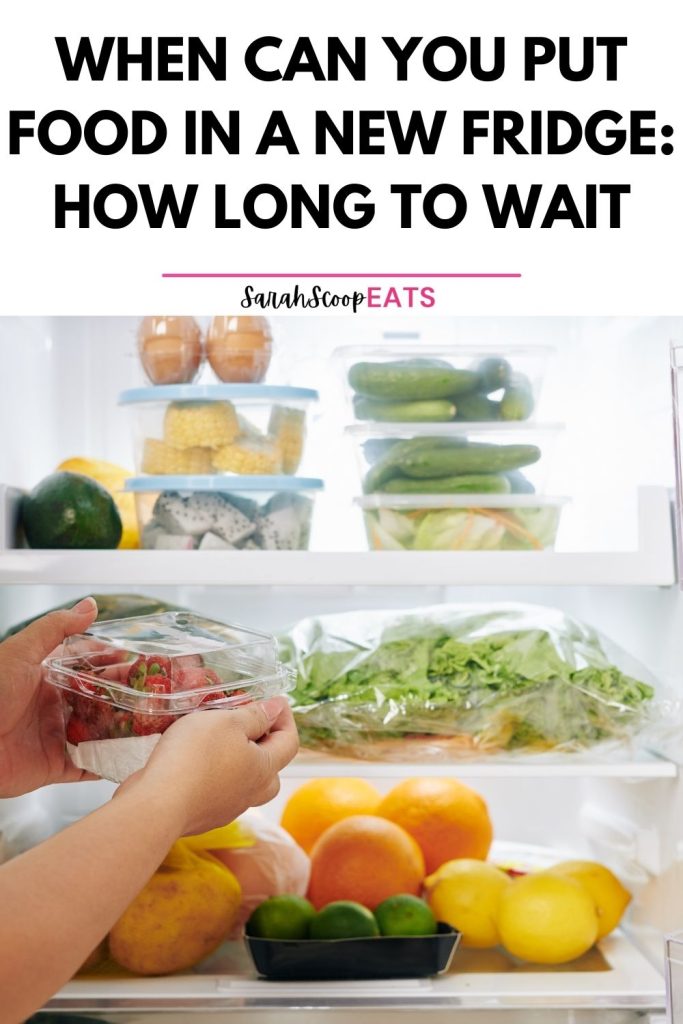
Get the scoop on more like this:


